26 Best Cities Skylines Tips: Build a Thriving City From Scratch
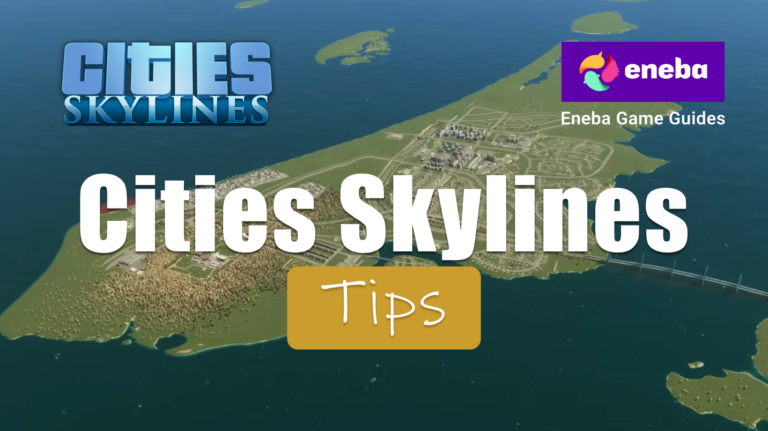
Cities: Skylines is one of those city-building games that blend deep systems with approachable mechanics. I still remember launching my first map, excited to craft a dream city, but quickly running into traffic jams, service issues, and budget problems. Through experimentation and hundreds of hours of play, I’ve learned many lessons that can help new players avoid common pitfalls. In this guide, I’ll share my most practical Cities Skylines tips to get your town up and running smoothly. We’ll start with foundational advice, move into more advanced strategies, and finish by pointing you toward some of our favorite resources and games on the Eneba Hub.
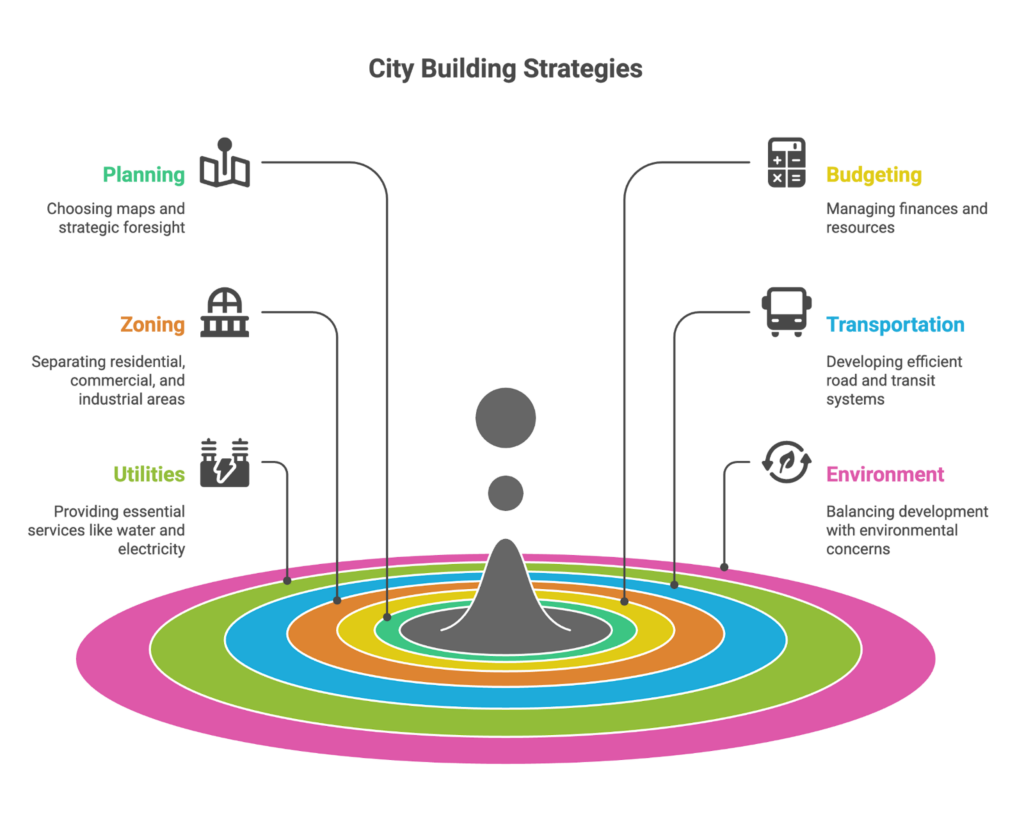
Jump to:
Cities Skylines Tips: Laying a Solid Foundation
The way you start a city strongly influences how it will develop. A good foundation means fewer headaches later, so take some time to plan before you unpause the simulation.
Tip 1 – Choose Your Map and Plan Ahead
Every map in Cities: Skylines offers different terrain, natural resources, and highway connections. Selecting a map with flat land and balanced resources makes expansion easier. Look at where rivers flow and where fertile land or ore deposits lie so that you can create industrial zones far from your residential area. Before placing anything, sketch a rough layout in your mind: where will the residential zones go? Where will your industrial and commercial areas sit? A clear vision prevents the sprawling cities that often cause congestion and pollution.
Tip 2 – Start Small and Control Your Budget
During the very beginning of the game, avoid overspending by only building what you need. It’s tempting to add police stations, clinics, and firehouses immediately, but most service buildings have a high upkeep cost. Start with basic services, such as electricity, water, sewage, and a simple road network, and hold off on additional facilities until the simulation notifies you of unmet needs. When you unlock taxation, set it around 11–12%; this provides a steady flow of tax income without making citizens unhappy. Use the budget panel’s sliders to adjust water budget, power budget, and service funding so that you’re not paying for unused capacity.
Tip 3 – Separate Residential, Commercial, and Industrial Zones
A well‑planned city needs space for people to live, places to work, and shops to visit. Keeping industrial zones away from residential zones reduces noise pollution and ground pollution. You can buffer these areas by placing commercial zones or office zones in between. Commercial areas can handle more noise, and offices create jobs without much traffic. Consider a specialized industry such as forestry or agriculture in the early game, as these types of natural resource extraction produce no ground pollution and can serve as buffers between dirty industry and residential neighborhoods.
Tip 4 – Lay Out a Simple Road Network
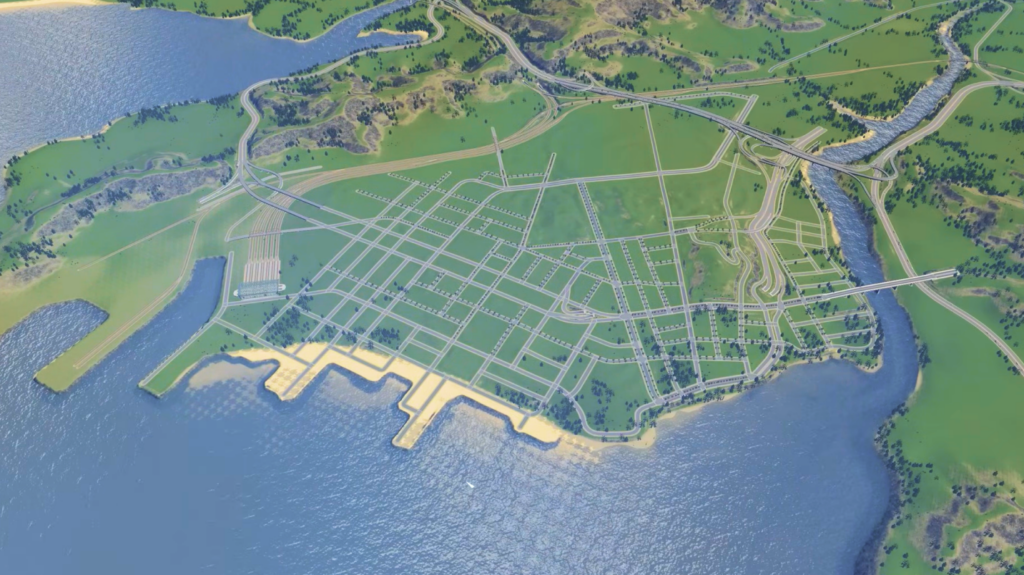
New mayors often build more roads than they need. Roads are not only expensive to build, but they also incur upkeep and generate traffic. Begin with a small two‑lane road to unlock additional road types. Keep initial roads in a grid or simple branching pattern to allow service vehicles to reach every building. Two‑lane or four‑lane roads are suitable for early neighborhoods because they carry electricity and water pipes cost efficiently and don’t create traffic lights at every intersection.
As your city grows, upgrade roads strategically. It’s wise to use dirt roads for undeveloped areas because they cost less and can be upgraded later. Avoid placing high‑capacity roads through residential areas since they increase noise pollution. Instead, plan a hierarchy of roads: small roads feed into medium arterial roads, which connect to highways.
If you’re seeking inspiration beyond this guide, check out the best city‑building games article. It rounds up top city builders, including Cities: Skylines, and offers perspectives on what makes each game unique. It’s a great read if you want to expand on your current urban planning horizons.
Planning Your Dream City: Road Networks and Traffic Flow
Traffic is the biggest challenge in Cities: Skylines because every citizen (nicknamed cims) and service vehicle follows the rules of the road. Poor road design leads to more traffic and unhappy citizens, so understanding how to shape road networks is essential.
Tip 5 – Build a Hierarchy and Use Roundabouts Wisely
In real life, traffic flows smoothly when roads follow a clear hierarchy: local streets feed collectors, collectors feed arterials, and arterials feed highways. The same principle applies in the game. Keep the majority of cars off residential streets by directing them onto larger roads and one-way streets when they need to travel longer distances. High‑capacity roundabouts can serve as efficient intersections. Larger roundabouts allow cars to maintain speed, whereas small circles slow vehicles down and cause congestion. When you build a roundabout, ensure each connecting road uses yield signs rather than traffic lights to maintain traffic flow.
Tip 6 – Space Out Intersections
Intersections slow down vehicles even when there are no traffic lights. A line of closely spaced intersections will make traffic crawl. To reduce this effect, combine nearby intersections or create back roads that connect neighborhoods without crossing main avenues. Give every neighborhood more than one entrance; this allows cars and garbage trucks to find alternate paths and reduces bottlenecks at entry points.
Tip 7 – Use One‑Way Roads and Highways Strategically
One‑way streets can improve traffic flow by preventing head‑on conflicts and guiding vehicles along specific routes. Convert busy downtown streets into one‑way loops to ease congestion and reduce traffic lights. On highways, use ramps and cloverleaf interchanges to separate merging lanes. Keep industrial and cargo traffic separate from commuter traffic by providing a dedicated highway connection to industrial zones. Consider using cargo stations (train or ship) to move raw materials and finished goods without clogging roads.
Tip 8 – Monitor Traffic and Adjust Signals
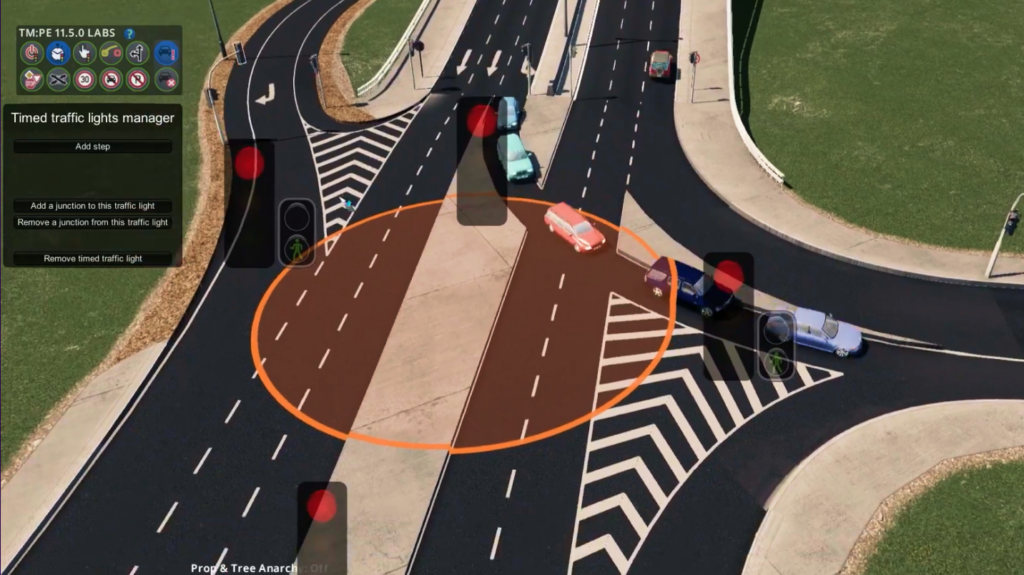
Cities: Skylines provides an info view that color‑codes traffic density. Green roads indicate smooth flow, while orange and red show congestion. Use this view to identify trouble spots and redesign them. The traffic routes view allows you to inspect which routes vehicles and pedestrians take. Adjust junction controls: sometimes switching a stoplight to a stop sign or yield sign solves the problem. Other times, upgrading a road to add turning lanes or even replacing an intersection with a roundabout is the best fix.
Tip 9 – Encourage Active Transport
Pedestrian paths and bike lanes act as free transit. Add sidewalks or elevated walkways to link homes with shops and parks; if walking is convenient, citizens leave cars behind. Elevated paths can also cross busy intersections without disrupting traffic.
For more insights into complex simulations beyond city design, take a look at our ultimate list of PC simulation games. We cover simulators that let you fly planes, drive trucks, and, of course, build cities. Exploring other genres gives you a fresh perspective on how to manage complex systems.
Managing Services and Resources Efficiently
Once you have a basic road network, your next priority is to supply electricity, water, waste management, and public safety. Managing these systems efficiently keeps your city running without draining your budget.
Tip 10 – Electricity: From Wind Turbines to Coal Power Plants
Early power production is straightforward: place wind turbines where the wind map shows strong gusts, and they’ll meet your initial needs. As demand rises, add coal or oil plants for higher output. Always site these facilities away from homes and parks to protect land value. Don’t overbuild power lines; electricity hops between adjacent buildings, so only span gaps or cross water when absolutely necessary.
Tip 11 – Water, Sewage, and Pollution Control
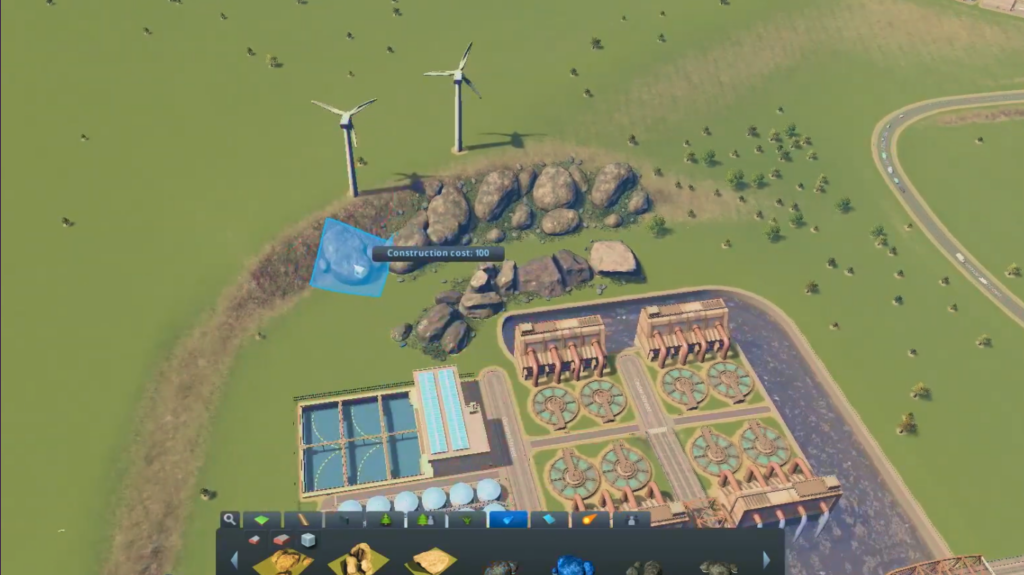
A single water pumping station and sewage outlet can serve the entire city in the early game. Place the water pump upstream and the drain pipe downstream to prevent sewage from contaminating your drinking water. If there is no river current, use water towers placed on uncontaminated ground. Manage the water budget slider so you don’t overpay for unused capacity; at a 50% budget, your pumps operate at 25% efficiency, which is plenty for small towns. As your population grows, add more pumps and drains before raising the budget back to 100%.
Tip 12 – Service Buildings: Only When Needed
Firehouses, police stations, clinics, and schools are essential but expensive to maintain. Wait until the game alerts you about unmet needs before adding more buildings. Coverage maps show how far service vehicles can reach; a well‑designed road network is often more important than having extra facilities. Facilities like landfills and cemeteries must be emptied before relocation, so place them where they can serve your city for a long time.
Tip 13 – Garbage and Cemeteries
Garbage trucks and hearses need clear routes to every neighborhood. Keep landfills or recycling centers near industrial zones and monitor capacity so you can upgrade to incinerators before they fill. Cemeteries and crematoria should be spread across the map to keep hearses from traveling long distances.
Tip 14 – Raising Land Value and Reducing Noise Pollution
Parks, plazas, and tree‑lined roads boost land value and make neighborhoods more desirable. Scatter small parks through residential areas and add larger green spaces near commercial districts. Trees along roads reduce noise, and office zones act as effective buffers between homes and busy streets. Always keep polluting industries and power plants far from housing.
On a related note, if you enjoy survival scenarios alongside city planning, our games like RimWorld article explores other colony‑management games that complement the city‑building themes of Cities: Skylines.
Optimizing Public Transportation
Public transport is an invaluable tool for reducing traffic, increasing land value, and connecting neighborhoods. It’s a system that requires careful planning but pays off by keeping your city moving.
Tip 15 – Start with Buses
Buses unlock early and are cheap. Use them to link residential, commercial, and industrial areas, keeping routes simple and avoiding overlapping lines. Dedicated bus lanes help them move smoothly, and you can check each line’s effectiveness by looking at the “car trips saved” statistic.
Tip 16 – Expand to Metro and Passenger Trains
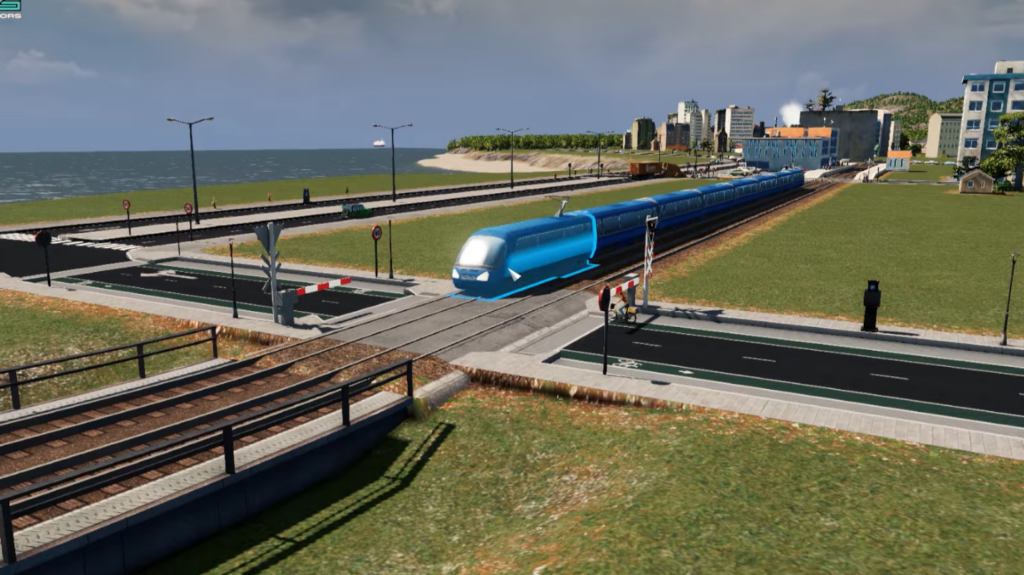
After buses, metros, and passenger trains move large numbers of people quickly. Build metro lines in high‑density areas and use trains to connect distant suburbs or tourist attractions. Place stations where they serve several zones to maximize ridership.
Tip 17 – Use Trams, Monorails, and Ferries
If you own expansions, trams, monorails, and ferries, provide alternatives to buses and metro. Trams run on tracks that can share roads, monorails operate on elevated lines, and ferries transport passengers across waterways without adding traffic.
Tip 18 – Manage Cargo Traffic
Industrial zones generate heavy cargo traffic. Reduce congestion by building cargo train or ship stations close to factories so goods travel by rail or sea rather than road. Keep cargo hubs away from residential districts to limit noise and pollution.
Tip 19 – Integrate Transit Hubs
Transit hubs that combine buses, metro, trams, and trains help passengers transfer easily. Place them near commercial or downtown areas to encourage walking and public transit, and be prepared to provide extra road capacity nearby.
Growing a Sustainable City: Land Value, Pollution, and Upgrades
After establishing essential services and transport, the next step is turning your town into a thriving eco city that your virtual citizens will love. This involves managing pollution, land value, and upgrades to keep the city attractive and prosperous.
Tip 20 – Balance Density and Growth
High‑density residential and commercial zones unlock once you reach population milestones. While larger buildings house more cims and increase tax income, they also produce more traffic and strain services. A sustainable approach is to mix low‑density and high‑density zones. Allow high‑density near transit hubs and keep low‑density neighborhoods farther out. Gradually upgrade residential area blocks to high density once your road network and public transportation can handle more vehicles.
Tip 21 – Use City Policies Wisely
Policies let you fine‑tune how your city operates. For instance, the “Smoke Detector Distribution” policy reduces fire risk at a modest cost, while “Heavy Traffic Ban” keeps large trucks out of residential districts. “Encourage Biking” promotes bike lane use and can reduce car traffic. Experiment with these policies in different districts to achieve specific goals like reducing noise pollution or conserving water.
Tip 22 – Harness Natural Resources with Specialized Industry
Natural resources, such as oil, ore, forests, and fertile land, are finite but lucrative. When you designate industrial zones over resource‑rich areas, they become specialized industries, producing higher tax income and different goods. However, the oil and ore industries generate heavy pollution and require a constant flow of raw materials. Forestry and agriculture produce no ground pollution, making them ideal near residential or commercial zones. Use a specialized industry to diversify your economy and avoid overreliance on a generic industry.
Tip 23 – Embrace Parks and Unique Buildings
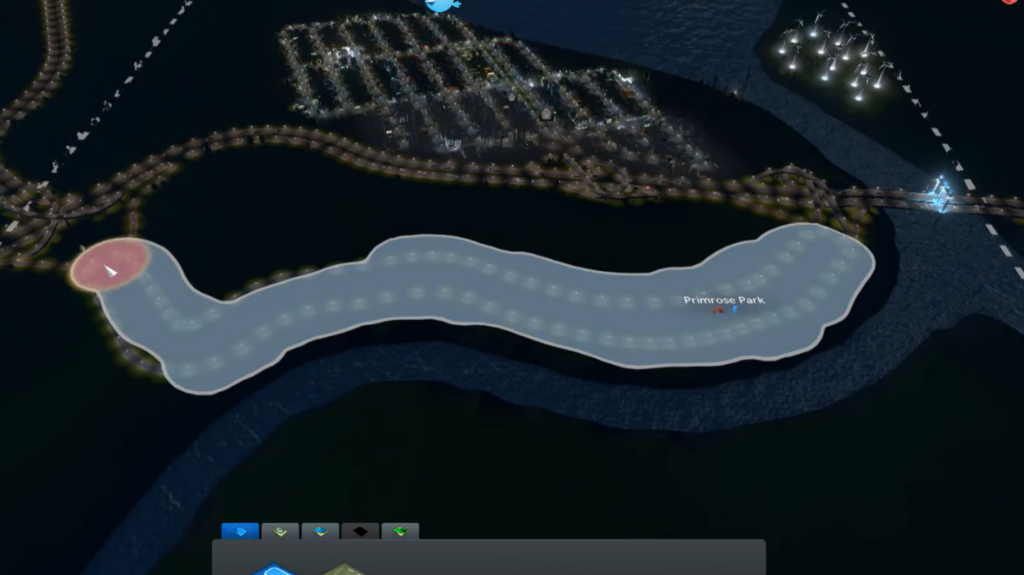
Parks are not just decorative; they boost land value and attract tourists. Build a variety of parks and plazas in each district to keep citizens happy. Unique buildings unlocked at population milestones provide tourism benefits and increase the attractiveness of your city. They are expensive to maintain, so place them strategically where they support nearby commercial areas without overwhelming your budget.
Tip 24 – Keep an Eye on the Environment
Pollution and noise can turn your dream city into a nightmare. Monitor the ground pollution and noise pollution info views. Position noisy facilities (industrial zones, power plants, cargo stations) away from housing. Use green roads and trees to reduce noise. Build water treatment plants and recycling centers to manage pollution as your city expands. Aim for a balance of nature and development to keep land value high and citizens happy.
Advanced Tips for Large, Sprawling Cities
Once your city reaches tens of thousands of residents, new challenges emerge. High traffic flow and service coverage become harder to maintain. These advanced tips will help you keep your metropolis running smoothly.
Tip 25 – Create Multiple Centers and Dedicated Corridors
Large cities work best when they don’t rely on a single downtown. Split your metropolis into several smaller centers connected by highways or high‑capacity transit. Assign each center its own mix of commercial and residential zones and build one‑way arterials or expressways to carry traffic efficiently between them. Parallel routes, one for inbound and one for outbound traffic, reduce weaving and congestion.
Tip 26 – Keep an Eye on Coverage Using Data Views
In a sprawling city, it’s easy to miss areas that lack police, fire, or healthcare. Regularly check the info views for services, traffic, pollution, and land value. Adjust budgets or add facilities where coverage is weak. Well‑served districts level up faster and contribute more tax income.
Leveraging Mods and Community Content (Optional)
Player‑made content can add flavor, but it’s best introduced after mastering the base game. Explore custom intersections and decorative assets carefully and read descriptions before adding them.
Bringing It All Together
Building a thriving city in Cities: Skylines takes planning, patience, and a willingness to adjust when things go wrong. Start with a small, well‑designed layout that separates residential, commercial, and industrial zones. Use a road hierarchy and roundabouts to keep traffic flowing, and introduce public transport early.
Expand services only when needed, and use specialized industry and parks to build an eco city that citizens love. When your city grows into a sprawling metropolis, decentralize its centers, space out intersections, and consider traffic management mods if you’re ready for the challenge. With these Cities Skylines tips, you’ll be well on your way to creating a dynamic town that runs smoothly and looks beautiful.
If you’re ready to put this advice into action, don’t forget that our Cities: Skylines Steam key is available in the Eneba Store. It’s a digital code that lets you dive into city planning on PC, Mac, or Linux. If you’re starting your very first town or aiming to refine your skills, having the game at your fingertips will let you test these strategies yourself.
I’ve poured countless hours into designing layouts and solving budget problems, and I still find new challenges every time I load up a new city. Grab the key and see how your urban planning skills measure up.
FAQs
How do I manage traffic in Cities: Skylines?
To manage traffic in Cities: Skylines, focus on building a clear road hierarchy and spacing out intersections. Use roundabouts and one‑way streets to keep vehicles moving and separate industrial traffic from residential routes. In addition, invest in public transportation so citizens have alternatives to driving, and monitor the traffic view to identify and fix congestion hot spots.
What is the best way to increase land value in Cities: Skylines?
The best way to increase land value in Cities: Skylines is to provide parks, plazas, and services within easy reach of your residential zones. Planting tree‑lined roads and creating green spaces reduces noise pollution and makes neighborhoods more desirable. Keeping pollution‑producing buildings away from homes and ensuring good access to schools and healthcare will also raise land value over time.
Can I use one‑way streets to improve traffic in Cities: Skylines?
Yes, you can use one‑way streets to improve traffic in Cities: Skylines. One‑way roads help control the direction of travel, reduce conflict at intersections, and guide vehicles along efficient routes. When implemented correctly, particularly in downtown or high‑density areas, one‑way systems can dramatically reduce traffic jams and improve service vehicle response times.
How do power lines and water pipes work in Cities: Skylines?
Power lines and water pipes in Cities: Skylines work by connecting service buildings to your zones. Electricity carries through buildings automatically, so only use power lines to bridge gaps where buildings don’t touch. Water pipes form a grid beneath your streets, supplying water and sewage services; keep them within road tiles to ensure coverage and avoid unnecessary overlap.
What are the benefits of specialized industry zones in Cities: Skylines?
The benefits of specialized industry zones in Cities: Skylines include higher tax income and efficient use of natural resources. Oil and ore industries produce profitable goods but create pollution and require raw materials. Forestry and agriculture produce no ground pollution, making them ideal buffers between industrial and residential areas. Specialized industry supports your city’s economy and diversifies your resource needs.
















